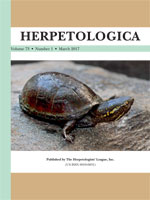There have been relatively few studies on the population structure of species from countries having high levels of biodiversity, such as Brazil, even though most species are at some risk of extinction. Precise estimates of population parameters, such as abundance and survival probability, are necessary for evaluating the status of populations and developing management policies for species and their associated habitats. Here, we used mark–recapture methods to model the demography of the sand lizard, Liolaemus arambarensis, an endemic species of southern Brazil. Specifically, we estimated population size, survival probability, and sex ratio of three populations, while accounting for imperfect individual detectability. Our goal was to evaluate how the population structure of this species reflects its conservation status according to the International Union for Conservation of Nature (IUCN) Red List. The estimated population size of mature individuals was higher than 250 individuals but lower than 2500 individuals; therefore, the species should be categorized as Endangered by IUCN population criteria. Monthly survival probability of adult females, adult males, and juveniles was relatively high (ranging from 0.74 to 0.85), whereas capture and recapture probabilities were low (ranging from 0.01 to 0.22). The accelerated degradation and alteration of sand lizard habitat, restinga areas of the Southern Coastal Plain, highlight the importance of long-term monitoring to detect future patterns of fluctuation and possible population declines of its few known populations.
How to translate text using browser tools
1 March 2017
Population Estimates for the Sand Lizard, Liolaemus arambarensis: Contributions to the Conservation of an Endemic Species of Southern Brazil
Lídia Farias Martins,
Murilo Guimarães,
Laura Verrastro
ACCESS THE FULL ARTICLE

Herpetologica
Vol. 73 • No. 1
March 2017
Vol. 73 • No. 1
March 2017
extinction risk
IUCN
Liolaemidae, Population size
Robust model
survival




